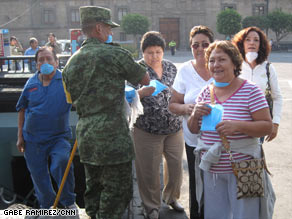Managing Your Anxiety about Swine Flu
The sudden and near-constant stream of news reports about swine flu can cause anyone to feel anxious and worried. These reactions are understandable because there are unknowns about the spread and severity of the illness. Even during this period of uncertainty, you can take several steps to manage your anxiety and have a positive outlook.
Keep things in perspective. Government officials need to prepare for worst-case scenarios in order to protect the public. The public, however, does not need to expect the worst. To date, the cases that have been identified in the United States are not severe. Americans who have contracted the illness have recovered.
Get the facts. Gather information that will help you accurately determine your risk so that you can take reasonable precautions. Find a credible source you can trust such as news from the U.S. Centers for Disease Control (http://cdc.gov/swineflu/), a local or state public health agency, or local elected official such as a state governor. This is a rapidly evolving situation, so gather information at regular intervals in order to help you distinguish facts from rumors. Be wary of unsubstantiated rumors, which can be upsetting and may deter you from taking appropriate action.
Maintain a hopeful outlook. Public health agencies around the globe are working on identifying outbreaks of the illness and to ensure the availability of the best medical care to those who are sick. Throughout the centuries, people have survived difficult life circumstances and gone on to live fulfilling and productive lives. There is no reason why this situation cannot be similar. Limit worry and agitation by lessening the time you and your family spend watching or listening to upsetting media coverage.
Stay healthy. A healthy lifestyle—including proper diet and exercise—is your best defense against any disease threat. Adopting hygienic habits such as washing your hands regularly will also minimize your exposure to all types of germs and disease sources. A healthy body can have a positive impact on your thoughts and emotions, enabling you to make better decisions and deal with the flu’s uncertainties.
Build resilience. Resilience is the process of adapting well in the face of adversity, threats or significant sources of stress. Draw on skills you have used in the past that have helped you to manage life’s adversities and use those skills to help you manage your emotions during this challenging time. See APA’s Road to Resilience brochure.
Have a plan. Think about how you might respond if swine flu were discovered in your area. You may want to stock up on non-perishable foods in case officials recommend staying home, explore options for working from home, and caring for sick family members, and establish an emergency family communication plan. Explore how you might spend your time if schools or businesses are closed. Working out some of these scenarios in advance can lessen your anxiety.
Communicate with your children. Discuss swine flu with honest and age- appropriate information. If your children have concerns, addressing those together may ease their anxiety and distress. Parents can also help allay distress by focusing children on routines and schedules that remain unchanged despite any changes due to swine flu preparations. Remember that children will observe adults behaviors and emotions for cues on how to manage their own emotions during this time.
Keep connected. Maintaining social networks can foster a sense of normality, and provide valuable outlets for sharing feelings and relieving stress. If officials have recommended limiting your social contact to contain an outbreak, you can stay connected via e-mail and telephone.
Seek additional help. If you have intense feelings of anxiety or hopelessness or are having trouble performing your job or other daily activities, a licensed mental health professional such as a psychologist can help you develop an appropriate strategy for moving forward. You can find psychologists near you by contacting your state psychological association or through APA’s psychologist locator.
A special thank you to: H. Katherine O'Neill, PhD; Ester Cole, PhD; and John R. Tassey, PhD for their assistance in preparing this document.
© 2009 American Psychological Association




















